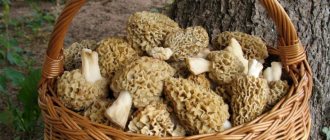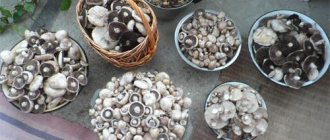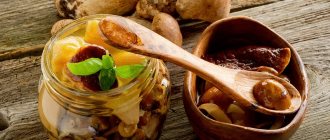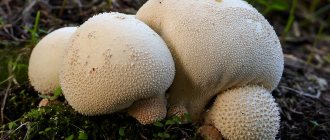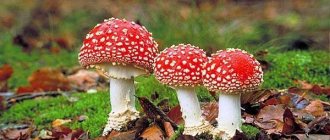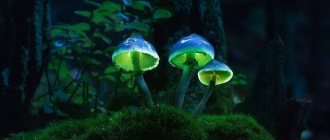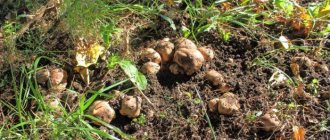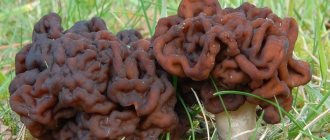General Guidelines for Cooking Enoki Mushrooms
Winter mushrooms attracted special attention from scientists in the 60s, when in one of the provinces of Japan, whose residents constantly included this product in their diet, an amazing pattern was noted - people suffered from cancer much less often than residents of other regions of the country. Product research has made it possible to establish the uniqueness of the components that make up mushrooms and their healing effects on the human body.
The word "enoki" is the Russian version of the Japanese "enokitake". The translation of the term has 2 versions - “noodle mushrooms”, as well as “mushrooms under the snow” or “Japanese snowdrop”, which is not surprising, because the growth of these representatives of the kingdom of wildlife occurs during periods of winter thaws. There are 2 types of Enoki - wild and cultivated. In Japan, small dense groups of enokitake can be seen on the bark of stone trees or on Chinese frames.
Under natural conditions, organisms grow quite thick and large with dark caps. Cultivated varieties are placed in special cylinders with sawdust. The mushrooms are cultivated in complete darkness, unlike the wild form, they have light yellow or white shades, reach a length of 12 cm, and have tiny sticky caps no larger than a button - up to 1 cm.
In Russia, this variety of honey mushrooms (Flammulina velvety-footed) is found in almost all regions. Mushrooms are creamy, yellowish or even brown in color.
The unique properties of Enoki are explained by the rich content of a whole complex of substances beneficial to the human body. This type of mushroom is considered harmless. Contraindications for use apply to pregnant women and children, patients with stomach ulcers and gastritis, people who have been found to be intolerant to the product or have an allergic reaction to it.
The table shows the composition and nutritional value of mushrooms:
| Nutrients | Amount per 100 gram serving |
| Water | 92.45 g |
| Carbohydrates | 3.26 g |
| Fats | 0.34 g |
| Squirrels | 3.09 g |
| Ash | 0.91 g |
| Calorie content | 22 kcal |
| Chemical composition | |
| Calcium | 14 mg |
| Iron | 8.3 g |
| Selenium | 54 mcg |
| Copper | 0.61 mg |
| Potassium | 3.1 mg |
| Sodium | 19 mg |
Enoki mushrooms, which are always healthy to cook, in addition to the listed components, contain micro- and macroelements, water-soluble B vitamins (1–6, 9), as well as vitamins E, D, D2, lipids, essential and non-essential amino acids.
To obtain the ideal dish from the presented component, it is necessary to take into account the following culinary principles:
- Before use, trim off the sponge-like base of the mushrooms, then rinse them thoroughly under running water. There are no other techniques or special rules for pre-processing the product.
- The main requirement for the ideal preparation of winter mushrooms is their fast, almost instantaneous heat treatment. However, this requirement does not depend on the specific dish in which mushrooms are included. By the time Enoki joins, the food should not be raw. The exception is certain types of sushi and rolls.
- Fry or boil mushrooms for no more than 7–10 minutes. If you leave honey mushrooms too long, they will acquire a “rubbery” taste.
- Raw foodists can afford to consume this product without preliminary heat treatment.
It is recommended to store fresh mushrooms in the refrigerator, placing them in “breathable” paper, then in a hermetically sealed bag or food container. When frozen, such raw materials will remain of the same quality and usefulness for 10–12 months, if you keep the workpiece at a temperature no higher than -18 °C.
Other white mushrooms
Some representatives of the mushroom kingdom are not white, but they may be. In order not to make mistakes when collecting, you need to carefully read the description, check the drawing and diagram of the sponge from photographs, and evaluate the juice on the cut. This must be done carefully and on the spot: a number of mushrooms are so dangerous that the poison can get on the samples and hands lying in the same basket.
Popular types:
- Russula (Rússula from rússulus “reddish”) is a lamellar mushroom with colors ranging from black to white. Harvested from spring to late autumn. Makes friends with birch, aspen, conifers, and is easily camouflaged. The empty taste is compensated by its prevalence. Suitable for frying, boiling. The name justifies it; it can even be eaten raw.
- Until the last decade, the semi-white mushroom (Hemileccinum impolitum) was classified as a boletus mushroom, but was later classified as a separate group. The cap porosity is fine and dense. The tubular surface turns yellow with age, but does not turn blue or violet when pressed. It differs from boletus in the smell of carbolic acid and the yellowish tint of the pulp. Prepared according to porcini mushroom recipes.
- Yellow hedgehog (Hydnum repandum) is a spongy mushroom with yellow or pink flesh that fades to white in hot weather. Dentium is edible the first week after germination (August - September). It has a unique fruity aroma that remains during cooking.
- Valuy (Rússula foétens), also known as goby, weeping mushroom, svinur, apricot, is a slippery oily ball on a long stalk, from which it easily breaks off when pressed. It has a color ranging from gray to dark brown. It is adjacent to larches and buries itself in heaps of leaves and needles. It retains density and crunch in pickles. It is called a plakun for the mucus on its ball cap, and a pig for its unpleasant characteristic odor. After cooking (pickle, marinade), both disappear. The density and crunch are preserved.
- Gray talkers (Clitócybe) growing on thin legs are often missed by mushroom pickers. Small (up to 3 cm) and difficult to transport, the fragile plastic cups look like toadstools. They settle in families in herbaceous plants (meadows, fields). You cannot collect talkers without experience. The species has more than a dozen poisonous relatives.
Cold appetizer with Enoki mushrooms
In the national cuisine of China, the presented treat is called “Liangban Jinzhengu”, it is extremely popular, often present on the table next to fatty dishes, since rice vinegar in food best promotes digestion.
Ingredients
To prepare the snack you will need:
- soy sauce - 2 tsp;
- rapeseed oil infused with huajiao - 2 tsp;
- carrots - 2 pcs.;
- canned enoki mushrooms (Golden threads) - 2 jars;
- cucumbers - 2 pcs.;
- finely ground salt - ½ tsp;
- rice vinegar (black) - 2 tbsp. l.;
- Ajzinomoto-Weijing (seasoning) - ½ tsp;
- sesame oil - 2 tsp;
- regular granulated sugar - 2 tsp.
A fresh product will be a worthy replacement for canned mushrooms. In the Middle Kingdom, it is customary to use almost any seasonal fruit as vegetables, making up a variety of culinary compositions.
Step-by-step cooking process
Sequence of stages of creating a dish:
- First you have to peel the vegetables, then you need to chop the cucumbers into strips.
- In the same form, you need to chop the carrots. It is advisable to chop the root vegetable using a special Korean grater for processing vegetables.
- Now you should heat drinking water in a saucepan. When it starts to boil, you need to salt the liquid, then put the carrot mixture into it, blanch the product for 2 minutes.
- After this, you need to take out the vegetables, immediately place them in a bowl of ice water, keep the slices in it for 2 minutes, then squeeze out the mass, put it in a spacious bowl.
- In the meantime, you should drain the brine from the enoki, place the mushrooms in a colander, rinse the product well, and leave the mushrooms in the same bowl to drain off excess moisture.
- Next, you need to combine vinegar, sesame oil, granulated white sugar, light soy sauce, Weijing seasoning, salt and Sichuan huajiao pepper oil in a bowl. The resulting composition should be mixed well.
All that remains is to place the processed vegetables in a serving bowl, treat the mass with fragrant sauce, and carefully distribute it among all components of the appetizer.
Dangerous mushrooms with plates under the hat
As already mentioned, many of the lamellar mushrooms are poisonous, which should never be collected or consumed. The consumption of such mushrooms will lead to sad consequences:
- Poisonous entoloma (also known as pink-plated plant). A very beautiful mushroom with a thick, dense, club-shaped stem and a large pale yellow cap up to 20 cm in diameter. The wide plates are light at first, then turn red. The pulp is unpleasant, with a bitter odor.
- Russula Meira. The small cap (no more than 7 cm) is pinkish in color, the plates are thick, white with a slight green-gray tint. The leg is white, dense, and turns yellow over time. The pulp smells like coconut, old mushrooms simply have a sweet aroma, but with a pungent taste.
- Porphyritic fly agaric. The brown-gray cap is first convex, then becomes concave, covered with scales. The leg is long, ringed at the top. The light pulp smells unpleasant.
- Earthen fibre. The white cap with a lilac tint is flat, swollen in the center. The leg is thin and fibrous. The plates are light, then darken.
Symptoms of poisoning may not appear immediately, or even be completely absent at first, but dangerous toxins will actually destroy your liver from the inside, so don’t take risks and it’s better to leave such mushrooms in the forest.
Lamellar mushrooms are one of the largest groups, including both valuable specimens for the kitchen and the most dangerous ones. Be careful when you go searching not to confuse them, and walk past unfamiliar mushrooms. Health is more important than experiments!
Chinese salad
The main rule of Chinese cuisine is to never use mayonnaise or sour cream as a dressing. For these purposes, it is necessary to use a mixture of various sauces. Regular salt is added to such food extremely rarely.
Ingredients
To obtain the dish you will need the components indicated in the table:
| List of products | Quantity |
| Sunflower oil | 100 ml |
| Fresh cucumbers | 2 pcs. |
| Glass noodles | 100 g |
| Winter honey mushrooms | 2 packages |
| Peppercorns | 4 things. |
| For the marinade | |
| Carnation buds | 2 pcs. |
| Filtered water | 500 ml |
| Laurel leaves | 2 pcs. |
| Table salt, table vinegar, granulated sugar | taste |
| For refueling | |
| Ginger and lemon juice | 2 and 4 tsp. respectively |
| Soy sauce | 6 tbsp. l. |
| Spices (salt, sugar and pepper) | according to preferences |
Enoki mushrooms (it is recommended to prepare salads not only with noodles, but also with meat, fish, and vegetable ingredients) can be used in snacks without marinating or cooking.
Step-by-step cooking process
The sequence of stages of creating food:
- Initially, you need to cut off the base of the mushrooms, then rinse the winter mushrooms well in running water.
- While excess moisture drains from the product, you need to combine all the marinade components specified in the recipe in a bowl and mix the composition thoroughly.
- Then you should transfer the Enoki into a convenient container, pour the resulting mixture over them, keep the honey mushrooms in this form for no more than 2 minutes, and then put them in the refrigerator for a day.
- When the mushrooms are marinated, you need to prepare the glass noodles. To do this, you need to place the product in a convenient container, pour boiling water over the product, leave it in this state for 5 minutes, then drain the liquid.
- Now you need to combine all the ingredients intended for dressing in a bowl, add spices to taste, and mix the composition well.
- Next, you need to chop the cucumbers into thin strips, transfer the slices into a deep salad bowl, add completely cooled noodles and mushrooms removed from the marinade to the vegetable, and season the combined products with fragrant sauce.
The prepared dish should be left to steep for 30 minutes, then served.
Conditionally edible varieties
Conditionally edible include:
- The row is purple with a smooth, dense stem, a purple cap, reaching up to 22 cm in diameter, in the form of a hemisphere. The edges are curved inward; as the fetus ages, the hemisphere opens slightly. The surface of the mushroom is smooth, without cracks. The mushroom is lamellar, with widely spaced plates at the bottom of the cap. The leg is 12 cm high, cylindrical in shape, tapering towards the top.
Row purple - Pepper milk mushroom is distinguished by a wide pepper-colored cap with edges curved inward. Young mushrooms are distinguished by the roundness of the cap, which later straightens out and becomes almost horizontal. The surface is smooth, slightly velvety. The whitish leg is 10 cm high, has a dense structure, and expands upward. Such mushrooms can be eaten and used for cooking only after careful heat treatment.
Pepper Milkweed
Mushrooms fried in batter
Winter mushrooms are a universal product, allowing you to get an original treat in an unusually used batter in just a few minutes.
Enoki mushrooms. How to cook in batter with hot pepper.
Preparation next.
Ingredients
To prepare the food you will need:
- premium flour - 60 g;
- sunflower oil - for frying;
- chili pods - 2 pcs.;
- Enoki - 400 g;
- chicken eggs - 2 pcs.;
- table salt - optional.
Step-by-step cooking process
Step-by-step cooking:
- First you need to put the eggs, scrambled with a fork, into a bowl, then add a pinch of salt and sifted flour (about 2 tbsp).
- The combined products must be thoroughly mixed, breaking up lumps, then continue the process until a homogeneous mass is formed with the consistency of not very thick sour cream.
- Then you have to wash the hot pepper pods, cut them crosswise into thin slices, and place them on a plate.
- Enoki should be removed from the bottom, rinse the product well, leave in a colander until excess water is removed, then disassemble the mass into small “bouquets”, approximately equal in the number of mushrooms.
- Next, we need to begin heat treatment of “silver threads,” as this type of mushroom with long thin stalks is commonly called.
- To do this, you should heat a frying pan, heat a little odorless oil in it, then put the honey mushrooms in hot fat. On standard dishes, no more than 2 selected bunches are usually placed.
- Place a circle of hot pepper in the center of each part of the mushrooms, then pour in approximately 2 tbsp portions. l. prepared batter, doing this along the long legs.
- The product must be fried for 2 minutes. on each side until a soft golden crust forms.
- The rest of the products will be used in this way.
Enoki mushrooms should be cooked no longer than the specified time, after which they should be beautifully laid out on a wide flat dish, and the food should be decorated with sprigs of herbs.
Mushroom picker's reminder
There are several rules that will help you avoid poisoning from collected mushrooms:
- Unidentified mushrooms should not be placed in the basket unless you are absolutely sure that they are edible.
- You should avoid mushrooms with a tuberous thickening at the base, covered with a shell. This is a sure sign of toxicity.
- It is necessary to pay attention to several signs: shape, color of the skin, color and smell of the pulp before and after the cut.
- There is no need to pick mushrooms within the city, as they become saturated with harmful substances.
- Mushrooms must be processed on the day of collection or the morning of the next day.
Reminder for collecting mushrooms
Conditionally edible mushrooms can be safely placed in the basket. To eat them safely, you need to know how to handle them. Due to their medicinal properties, these mushrooms are used for medicinal purposes.
What conditionally edible mushrooms grow in your area? Do you collect them? How do you cook? Share your experience in the comments.
Fried with meat
The presented variety of honey mushrooms goes well with meat, which is why oriental cuisine has many different variations of dish design.
Ingredients
To create a treat you will need:
- sunflower oil - for frying;
- Enoki - 400 g;
- pork - 400 g;
- hot pepper pods - 2 pcs.;
- soy sauce - 2 tbsp. l.;
- ginger root - 20–30 cm;
- starch - 2 tsp;
- garlic cloves - 4 pcs.;
- table salt, sesame oil - according to preference;
Step-by-step cooking process
Sequence of cooking steps:
- Initially, you need to wash the meat, strip it of films and tendons, pat the piece well with disposable towels, then cut the pork into thin strips.
- Now you need to marinate the meat, for which you need to place the product in a deep bowl, lightly salt the pieces, add starch and a few drops of sesame oil.
- The resulting mass should be mixed well and left in this form while processing the remaining components of the dish.
- After this, it is necessary to separate the lower part from the Enoki legs, thoroughly rinse the mushrooms, drain the remaining water from them, then separate the mushrooms from each other.
- The hot pepper pods, cleared of seeds, should be cut into halves, then chopped into thin long strips.
- Finely grate the garlic cloves and peeled ginger root.
- Next you need to start frying the food. To do this, you need to heat the frying pan well, then heat the sunflower oil in it.
- Then you need to put the marinated meat in hot fat and fry it with occasional stirring until completely cooked. The process will take no more than 3–4 minutes. Do not keep the pieces in the container for longer so that the pork does not become dry.
- Then you need to remove the pork from the frying pan, pour ginger and garlic into the free space, heat them slightly over medium heat, after a slight aroma appears, you need to add hot pepper strips to the spicy vegetables, as well as prepared mushrooms.
- Fry the mixture for no more than 1–2 minutes. with constant stirring. During this short period of time, the honey mushrooms will become soft, so they can be slightly salted. This stage of preparation is the most important in the technological process. If even 1 min. overexpose the mushrooms, they will lose their fragility and instantly become “rubbery”.
- Now you should add the meat to the composition, turn off the heat, and mix the ingredients of the dish.
The resulting treat is equally tasty either hot or slightly cooled.
With steamed garlic
Enoki mushrooms, prepared in this way, are a healthy dietary dish.
Preparation next.
Ingredients
To prepare the treat you will need:
- vegetable and sesame oil - 4 tbsp. l. and ½ tsp. respectively;
- regular granulated sugar - 1 tsp;
- Enoki mushrooms - 4 packs;
- oyster and soy sauce - 2 and 4 tbsp. l. respectively;
- chicken broth (granulated) - ½ tsp;
- garlic cloves - 2 heads;
- chili pods - 2 pcs.;
- sprigs of cilantro, green onions - to taste.
Step-by-step cooking process
The sequence of stages of creating food:
- First, you need to pour about 2 liters of drinking water into the steamer pan, then place the container on the stove to heat.
- In the meantime, you have to prepare all the components of the future dish, for which you need to cut off the outer part of the mushrooms, the rest of the mass needs to be rinsed well and left in a colander to drain the liquid.
- Garlic should be peeled, split the cloves in half, press them down with the flat side of a hatchet, then chop the vegetable.
- The chili pods, cleared of seeds, need to be finely chopped and the onion feathers should be shaped into small rings.
- Now you need to combine granulated chicken broth in a bowl (you can use table salt instead), granulated white sugar, both types of sauces, pour in a few drops of sesame oil.
- The resulting dressing should be mixed well.
- All that remains is to assemble the dish, for which you need to arrange small bunches of mushrooms on a wide flat plate. You can do this in 2 overlapping rows, placing the Enoki heads in one direction.
- Sprinkle the mushrooms with garlic on top, pour the resulting sauce over the mass evenly, place the workpiece in the casket of a double boiler, cover the dish, and place it in a unit with already boiling water. Cooking time - 7 minutes.
- After the specified period, you are supposed to take the food out of the device, sprinkle the food evenly with pieces of hot pepper and slices of green onions.
It remains to heat 4 tbsp in a frying pan. l. sunflower oil, pour the hot mixture over the plate with the treat, garnish the food with cilantro sprigs.
Salad with crab sticks and Enoki mushrooms
Excellent recipes for snacks with winter mushrooms can be chosen from Japanese cuisine, the traditions and special philosophy of which have developed over many centuries. Thus, not a single dish on the table is the main thing - every treat is considered a culinary creation and a real masterpiece.
Ingredients
To prepare the snack you will need:
- deodorized sunflower oil (odorless) - 4 tbsp. l.;
- green beans - 240 g;
- balsamic vinegar - 2 tbsp. l.;
- Enoki - 800 g;
- onion - 2 pcs.;
- crab sticks - 220 g;
- young cucumbers - 2 pcs.;
- bell peppers - 2 pcs.;
- fresh basil - 20 g.
Step-by-step cooking process
Step-by-step salad preparation:
- Initially, you need to separate the ends from the bean pods and cut them slightly diagonally into small pieces.
- After this, you need to boil filtered water in a saucepan, lightly salt the liquid, then carefully lower the processed legumes.
- The product should be cooked for 5 minutes. from the beginning of a new bubbling, then you need to remove the beans from the container with a slotted spoon, immediately place the mass in ice water, after 5 minutes. drain the liquid.
- In the meantime, you need to boil the Enoki as usual (boil for no longer than 2 minutes), then soak the mushrooms in cold water after 2 minutes. transfer the honey mushrooms to a colander.
- Cucumbers should be cut into strips, crab sticks should be cut into thin strips, and the peeled onions should be chopped.
- Next, you need to combine all the processed ingredients in a deep salad bowl, salt and pepper the composition, and season it with a mixture of vinegar and sunflower oil.
Before serving, the dish should be decorated with basil leaves.
Beneficial properties of enokitake mushrooms
These mushrooms contain linoleic acid, chitosan and dietary fiber. It has been proven that raw mushrooms contain twice as much fiber as cabbage.
Linoleic acid, chitosan, as well as dietary fiber provide the main benefits of mushrooms, especially in the ability to eliminate fat in the intestines, control blood sugar levels, and prevent intestinal problems. Listed below are some of the popular benefits of enokitake mushrooms.
1) Immune-boosting benefits
Enoki mushrooms provide a smorgasbord of nutrition and are rich in antioxidants. They are full of thiamine, niacin, potassium, riboflavin, pantothenic acid, calcium, copper, iron and selenium, and are low in cholesterol and sodium.
The amino acids valine, lysine and ergothioneine strengthen the body's immune functions. Mushrooms are prized for their health benefits and have been used in traditional Chinese and Japanese medicines for hundreds of years as a tonic to treat liver disease, high cholesterol, stomach ailments, and high blood pressure.
2) Helps remove fat from the intestines
These mushrooms are suitable as a source of non-meat conjugated linoleic acid (CLA), which helps reduce body fat. Mushroom CLA has the same weight loss benefits as CLA from meat sources.
Enoki mushroom is composed of linoleic acid, which also reduces fat in the intestines. Thanks to the acid, enzymes responsible for burning visceral fat are activated. Therefore, regular consumption of enoki will help reduce body fat.
3) Stabilize sugar
There are quite a few benefits of consuming fiber in your daily diet, such as lowering cholesterol levels as well as reducing unwanted weight.
Additionally, another benefit of dietary fiber is in controlling sugar levels. This control means that less sugar is stored as fat and you begin to lose weight.
Enoki are full of dietary fiber, which will help you manage your glucose levels. However, fiber may help improve blood glucose levels simply by reducing the effect on insulin glucose levels. In other words, you slow down the absorption of sugar, which means you stop your body from storing fat. Additionally, mushrooms work as a precaution against type 2 diabetes.
4) Prevent constipation and normalize intestinal motility
The fiber in mushrooms helps normalize bowel movements and prevent constipation. 12 grams of dietary fiber are found in 300 grams of mushrooms, which means that enoki constitutes 30 to 50% of the daily fiber intake for people over 50 years of age. However, you need to remember that people under 51 need more fiber.
Not getting enough fiber in your daily diet can interfere with normal bowel movements and lead to constipation. Enoki are one of the best sources of low-calorie dietary fiber to prevent and prevent constipation.
5) Stimulate intellectual development
Enoki mushrooms contain ample amino acids that promote and encourage mental development and also improve memory. They are necessary to maintain the health and enhance the intelligence of children, to prolong the life of the elderly, and also to improve the memory of adults. This is indeed a great honor for a simple mushroom that stimulates intellectual development.
6) Prevent allergies
Frequent use of enoki in food helps prevent asthma, rhinitis, eczema, and other allergic reactions. So, include these beneficial mushrooms in your daily diet to maintain health and prevent allergies.
7) Reduce blood lipids
Enoki mushrooms help prevent high blood lipid levels, lower cholesterol to avoid hyperlipidemia, and reduce the likelihood of coronary heart disease.
Stimulates metabolism
Regular consumption of mushrooms promotes the biological activity of the body, improves the metabolic process, which stimulates the absorption of nutrients.
Enoki soup in fish broth with Chinese radish
Enoki mushrooms (you can prepare hot liquid food based on the type of fish chosen to your taste) are a delicacy product, the most eaten in Japan and China, regardless of which dish this component is added to.
Ingredients
To create the dish you will need:
- fish broth - 1 l;
- large shrimp - 100 g;
- daikon - ½ root vegetable;
- Enoki mushrooms - 60–70 g;
- egg - 1 pc.;
- green onion feather - a small bunch;
- okra (okra) - 100 g;
- table salt - according to preference.
Step-by-step cooking process
Step-by-step execution of the recipe:
- First you need to rinse half of the daikon well, then cut it using a special Korean device.
- The okra should be chopped into small rings and the onion should be chopped in the same shape.
- Peeled shrimp should be divided in half.
- The mushrooms should be freed from the bottom, rinsed well, and left in a colander.
- Now you need to heat the pre-boiled fish broth to a boil, put okra and daikon into it, and add salt to the liquid mixture to taste. If desired, along with these ingredients, you can add peeled and chopped potato tubers, as well as chopped carrots, to the future soup. This addition will make the food more satisfying and nutritious.
- After the broth begins to boil again, cook the food for approximately 6–7 minutes.
- Next, you need to put mushrooms, parts of shrimp, and ½ the number of green onion rings into a container.
- At the same time, you need to beat the egg with a whisk, pour it in a thin stream into the pan, after 1 minute. heating should finish cooking.
When serving the soup to the table, portions of the remaining greens should be added to the bowls with the treat.
To take or not to take
The main part of semi-edible mushrooms has a pleasant taste and nutritional qualities. The most important thing is to correctly identify them and prepare them accordingly. If a mushroom picker makes a mistake by confusing a conditionally edible mushroom with an inedible one, or does not subject it to proper culinary processing, the matter may result in health problems, even death.
It is important to know and follow the rules for preparing semi-edible mushrooms
Useful tips and tricks
Enoki, like other types of zukaryotic organisms, require special treatment when used for culinary purposes, therefore, in the process of creating a dish, the following rules must be taken into account:
- To obtain tasty and healthy food for the body, it is recommended to use winter mushrooms in exceptionally fresh and high-quality condition. The growing season of wild mushrooms is autumn - spring. It should be borne in mind that Enoki collected in winter are not wormy.
- When choosing mushrooms, you need to pay attention to their appearance. Preference should be given to intact specimens with a pleasant mushroom aroma and elastic flesh, with intact white caps without dents or spots uncharacteristic of this type.
- The presence of mucus on winter mushrooms indicates that their shelf life has expired. If there are any signs of deviations from the recommended characteristics of the product, it is better not to risk the health and quality of future food - simply dispose of suspicious specimens.
- Tender and fragrant winter mushrooms have long been considered an excellent component for preparing a variety of oriental soups. Moreover, mushrooms were added not only as a satisfying and nutritious ingredient, the best substitute for meat, but also to decorate the finished dish.
- “Japanese snowdrops” taste especially delicious in salads, where it is recommended to add the product raw.
- An excellent option would be winter mushrooms rolled into sushi or spring rolls, wrapped in thin layers of beef or bacon.
Mushrooms called “Enoki” go well with almost all foods, so you can cook them, for example, with noodles, lemongrass, soy, ginger, fresh herbs, butter and countless different seafood.
Lamellar delicious mushrooms
Despite the fragile flesh, which often breaks during cooking, lamellar mushrooms are very good, especially when fried or pickled. But, unfortunately, they are rarely used for soup for the same reason, except for honey mushrooms and some other types - they are more elastic and hold their shape better than others.
Among the edible agaric mushrooms that deserve attention:
- Lemon oyster mushroom. One of those mushrooms with which you can do anything, including boiling, it’s a pity that it grows only in the Far East. The caps are small, maximum 10 cm, of a beautiful lemon color, the plates smoothly turn into a rather long stalk, like an oyster mushroom (about 9 cm), which initially grows in the center, but shifts with age. The pulp is white and tender, smells like flour, but in old mushrooms it becomes coarse.
- Wet pink. Despite the nasty mucus that completely covers the light brown cap with rare dark spots, the mushroom is very tasty when fried and pickled. The only thing that needs to be taken into account is that the thick plates under the cap should still remain white, because in old mushrooms they turn black and the mushroom loses its presentation, especially when boiled.
- Gossamer violet. One of those mushrooms that is difficult to confuse - its purple color immediately attracts attention, but should not scare away, since the mushroom is quite edible. The slightly convex cap below has darker plates and stands on a rather high stem. The pulp is the same color and smells like leather.
- Russula blue. It is characterized by a fleshier cap with thick white plates, while the cap itself is colored a beautiful blue-lilac color with a darker center. The white stalk in the center is slightly thicker. The pulp is light and pleasant to the taste.
- Forest champignon. One of the most delicious mushrooms with unusually aromatic and sweet light flesh, which turns slightly brown when broken. It differs from its “pale-faced brothers” in having a brown cap covered with scales.
Most lamellar edible mushrooms are more tasty when they are young, but in older specimens the plates often darken, and the flesh either becomes completely “crystal” and falls apart when you try to cut the mushroom, or it becomes hard and has an unpleasant taste.




